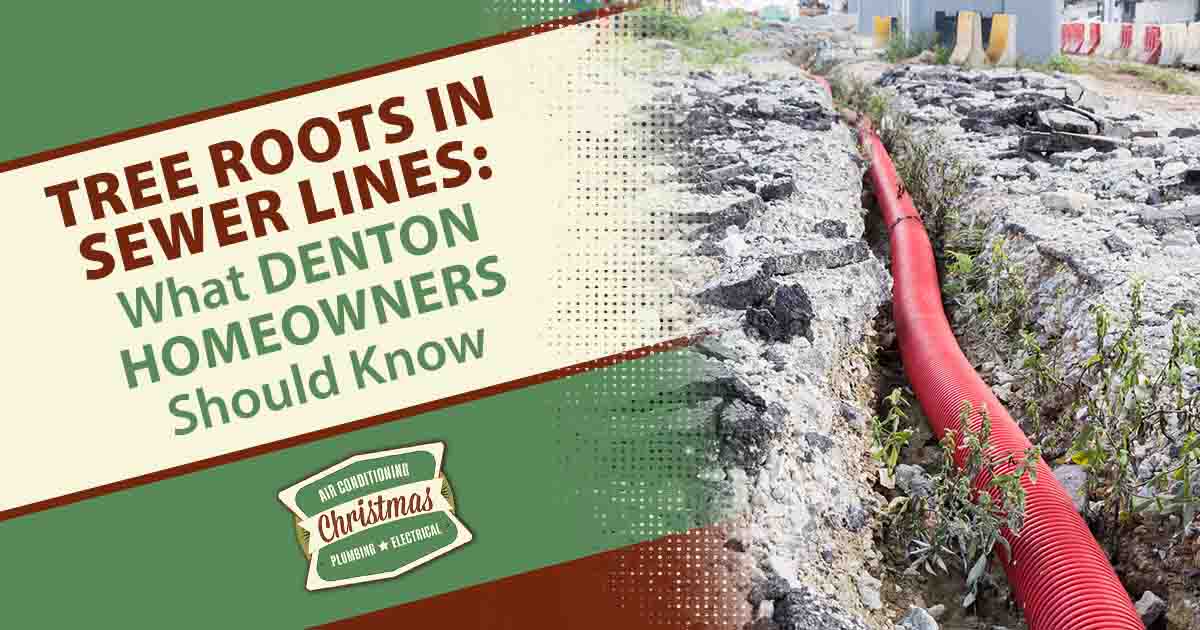Tree roots in sewer lines are a common issue for homeowners in Denton, especially those with older homes or tree-lined properties. When roots invade sewer pipes, they can cause significant plumbing problems, ranging from slow drains to costly repairs. This blog, based on the services offered at Christmas Air Conditioning and Plumbing’s sewer line cleaning and repair page, explains why tree roots enter sewer lines, what warning signs to look out for, and what homeowners in Denton can do to prevent and address the issue.
Why Tree Roots Invade Sewer Lines
Tree roots grow toward moisture, making sewer lines a natural target for growth. Even a small crack or loose joint in a sewer pipe can release vapor that attracts nearby roots. Once roots enter the pipe, they expand and multiply, creating blockages that further damage the pipe.
Older homes in Denton are especially vulnerable. Many were built with clay, cast iron, or Orangeburg pipes, which are more likely to crack or shift over time. These materials create easy entry points for roots to take hold and grow inside the sewer line.
Tree-lined neighborhoods—common in Denton—also face a higher risk of root intrusion. Fast-growing species like willows, maples, and elms have aggressive root systems known to damage underground pipes.
By understanding how and why roots grow into sewer lines, Denton homeowners can take early steps to protect their plumbing systems and avoid major repairs.
Early Signs of Tree Roots in Sewer Line Systems
Homeowners often overlook the early warning signs of tree roots in sewer lines until the damage becomes more severe. Recognizing these signs early can help prevent backups, water damage, and expensive repairs.
One of the first signs is slow drainage throughout the home. If multiple drains—such as toilets, tubs, and sinks—start to empty more slowly than usual, it may indicate a partial blockage in the main sewer line caused by growing roots.
Another standard indicator is the presence of gurgling sounds coming from the toilet or drains. These sounds often occur when trapped air escapes as wastewater attempts to pass through a root obstruction. Homeowners may also notice sewage odors, which signal a crack or breach in the pipe where gases are escaping—often a result of root invasion.
Outside the home, wet patches or sinkholes in the yard may be visible above the affected sewer line. These spots form when wastewater leaks out of the pipe and saturates the soil, sometimes causing the ground to shift or collapse.
In many cases, homeowners may try temporary fixes, such as plunging or using store-bought drain cleaners. However, if these symptoms keep returning, it’s likely the issue goes deeper—literally—into the underground sewer line. Tree roots growing in sewer pipes will not go away without professional removal and repair.
Professional Diagnosis: Detecting Tree Roots in Your Sewer Line
Accurately identifying tree roots in a sewer line requires more than just guesswork or basic tools. Denton homeowners experiencing repeated clogs or sewer odors should consider scheduling a professional inspection to confirm the presence and extent of root intrusion.
Video camera inspections are the most effective method for detecting tree root blockages. A specialized waterproof camera is inserted into the sewer line to provide real-time visuals of the pipe’s interior. This method enables plumbing professionals to locate root masses, cracks, or joint separations with precision—without disturbing the yard.
In addition to identifying tree roots, camera inspections also reveal pipe conditions, such as corrosion, bellies, or past repairs that may be contributing to ongoing issues. This information is essential for determining whether cleaning, repair, or complete replacement is necessary.
DIY methods, such as chemical root killers or repeated snaking, may offer temporary relief but rarely address the root cause. Without visual confirmation, these approaches can miss more profound or multiple problem areas, allowing roots to continue growing inside the system.
For Denton properties with large trees or aging plumbing infrastructure, routine camera inspections can help identify root problems early, preventing them from escalating into more serious and costly repairs.
Treatment Options for Tree Roots in Sewer Lines
Once tree roots have been confirmed in a sewer line, professional treatment is necessary to clear the blockage and prevent further damage. Several effective options are available, depending on the severity of the intrusion and the condition of the pipe.
Mechanical Removal (Snaking)
One of the most common methods is mechanical root removal, which involves using a drain snake fitted with a rotating cutting head. This tool physically cuts through the roots, restoring partial flow in the line. While snaking is helpful for quick relief, it often leaves root fragments behind, allowing regrowth over time. It’s best used as a short-term or emergency solution rather than a permanent fix.
Hydro-Jetting
Hydro-jetting is a more advanced and thorough solution. This method uses a high-pressure stream of water to remove roots, grease, and debris from the entire inner surface of the sewer pipe. When performed by trained professionals, hydro-jetting is safe for most residential pipes and highly effective at eliminating both roots and buildup.
Chemical Root Killers
In some cases, chemical root treatments are used to supplement mechanical or hydro-jetting services. These products contain slow-acting herbicides that prevent regrowth without harming surrounding trees or soil. However, chemical solutions should only be applied by a licensed plumber and are not a standalone fix for severely damaged pipes.
Choosing the proper treatment depends on factors like pipe age, material, and the extent of root intrusion. A professional assessment will determine the safest and most effective option for long-term results. For Denton homeowners, investing in a comprehensive treatment plan now can help avoid future backups, pipe failures, and costly repairs.
Sewer Line Repair or Replacement: When It’s Necessary
In some cases, removing tree roots from a sewer line may not be enough—mainly if the roots have caused significant structural damage. When pipes are cracked, collapsed, or repeatedly invaded, repair or replacement becomes the most reliable long-term solution.
Two primary methods are commonly used:
Pipe Bursting
Pipe bursting is a trenchless method that involves breaking the old, damaged pipe while simultaneously pulling in a new one. It’s ideal for situations where roots have extensively damaged the pipe, but the surrounding soil and alignment are still stable. This method minimizes surface disruption, making it a practical choice for homeowners with landscaped yards or driveways above the sewer line.
Traditional Trench Repair
Excavation and trench repair may be necessary when the damage is isolated or when access to the pipe is difficult due to improper installation or shifting soil. This method provides direct access to the damaged section and may be necessary in homes with multiple problem areas or older plumbing materials.
In both cases, upgrading to PVC or HDPE pipes, which are more resistant to root intrusion, is recommended. These modern materials feature sealed joints and smooth interiors, reducing the risk of future clogs and root entry.
A trusted local plumber can help Denton homeowners evaluate whether targeted repair or full replacement is the better long-term solution—especially if previous fixes haven’t resolved the issue permanently.
Preventing Tree Roots from Damaging Sewer Lines
Preventing tree roots from entering sewer lines is far more cost-effective than dealing with repairs. Denton homeowners—especially those with older pipes or mature landscaping—can take several proactive steps to reduce the risk of root intrusion.
Routine sewer line inspections are one of the most effective preventative measures. Regular video inspections help identify minor issues before they turn into significant problems, such as hairline cracks or early root entry.
Homeowners should also be strategic with their landscaping choices. Avoid planting trees with aggressive root systems near the path of sewer lines. Species such as willows, silver maples, and elms are known for invasive roots and should be placed far from underground utilities. If trees are already established near the sewer line, installing root barriers can help redirect roots away from vulnerable pipes.
Scheduled sewer cleanouts, especially in older homes, can remove minor root intrusions or debris before they cause complete blockages. A professional plumber can recommend a cleaning schedule tailored to the home’s specific plumbing materials, yard layout, and tree coverage.
Taking preventive action now can protect both the plumbing and the property’s structural integrity. For Denton residents, partnering with a local plumbing expert like Christmas Air Conditioning and Plumbing ensures long-term solutions and peace of mind.
Call Christmas Air Conditioning and Plumbing for Expert Sewer Line Solutions
If you suspect tree roots are affecting your sewer line—or want to prevent future damage—trust the professionals at Christmas Air Conditioning and Plumbing. Serving Denton homeowners with reliable sewer line inspections, cleaning, and repairs, our experienced team is ready to help.

